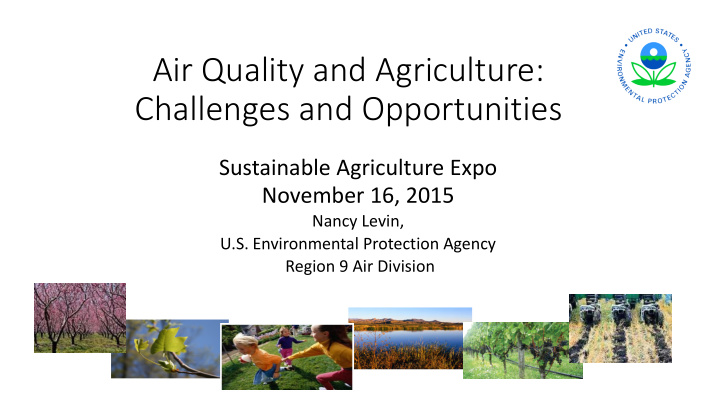



Air Quality and Agriculture: Challenges and Opportunities Sustainable Agriculture Expo November 16, 2015 Nancy Levin, U.S. Environmental Protection Agency Region 9 Air Division
The average adult breathes 3,000 gallons of air every day.
Contents I. Air Quality and Public Health II. National Air Quality Standards III. Sustainable Agriculture is part of the Air Quality solution
I. Air Quality and Public Health
U.S. EPA’s Mission “Protect Human Health and the Environment”
Awareness of air pollution 1943 - Los Angeles 1 st recorded photo of smog 1930’s dust bowl 1953 – London nearly 4,000 suffocate
Many Sources of Smog and Air Particles
How Is Ozone (Smog) Formed?
Ozone exposure can… • Irritate respiratory system. • Reduce lung function. • Inflame and damage cells. • Aggravate asthma, emphysema, chronic bronchitis. • Cause permanent lung damage. http://www3.epa.gov/apti/ozonehealth/population.html http://cfpub.epa.gov/airnow/index.cfm?action=aqi_brochure.index
People most affected by ozone exposure Children are at higher risk. So are… People with lung disease. Older adults. Active people of all ages. http://www.stateoftheair.org/2015/key-findings/people-at-risk.html
Particulate Matter (PM) PM 10 (microns in diameter) PM 2.5 (microns in diameter)
Size of Particle Pollution
Particulate Matter -- Lungs and Heart • difficulty breathing, irritated airways • aggravated asthma decreased lung function • nonfatal heart attacks, irregular heartbeat • premature death in people with heart or lung disease • In California, 9,000 people are estimated to die prematurely each year as a result of exposure to fine particle pollution. http://www.stateoftheair.org/2015/key-findings/; http://www.epa.gov/asthma
II. National Ambient Air Quality Standards
1977 Clean Air Act and 1990 Amendments Title I: National Air Ambient Quality Standards Title II: Mobile Sources Title III: Toxics Title IV: Acid Deposition Title V: Permits Title VII: Enforcement
Air pollution levels have decreased in CA 150 140 8-hour ozone NAAQS 8-hour Ozone Average concentration (ppb) San Francisco Bay Area, CA 130 San Joaquin Valley, CA Los Angeles-South Coast Air Basin, CA 120 110 100 90 80 70
Emissions Drop – Economy Grows
…But Challenges Remain CA = 34 million, 23% 2
National Ambient Air Quality Standards (NAAQS) for Six Common Pollutants Ozone Particular matter – Fine (PM 2.5 ) and Coarse (PM 10 ) Carbon monoxide Sulfur dioxide Nitrogen dioxide Lead ~ ~ NAAQS are health-based standards based on most recent science. ~ ~
NAAQS and Nonattainment Areas If an area exceeds (does not “attain”) the NAAQS … “Nonattainment Area” An area is nonattainment if it violates the NAAQS or contributes to a nearby area that violates.
California’s Unique Challenges 1. Public health - Worst air quality in US • Population growth, topography & climate 2. Ports and goods movement corridors • Emissions from trains, trucks and ships 3. Major Industrial, Commercial, and Agricultural Sources • Intractable problems requiring new technologies
Maps tell the story….
8-Hour Ozone Nonattainment Areas (2008)
24-Hour PM 2.5 Nonattainment Areas
NAAQS are Updated Review air quality standards every 5 years. Propose new standard (or range). Holds public hearings, public comment period. Finalize new standard. 2008 – Ozone standard set at 75 parts per billion (ppb) After 2008 – Studies found 75 ppb not sufficiently protective of public health. 2015 – new Ozone standard at 70 ppb. 26
Recent NAAQS by Pollutant Pollutant Year Level* Averaging Time Ozone 2008 75 ppb 8-Hour Ozone 2015 70 ppb 8-Hour 12 μ g/m 3 PM2.5 2012 Annual PM2.5 35 μ g/m 3 2006 24-Hour Sulfur Dioxide 2010 75 ppb 1-Hour Lead 0.15 μ g/m 3 2008 Rolling 3-Month Nitrogen Dioxide 2010 100 ppb 1-Hour 150 μ g/m 3 PM 10 1997 24-hour * μ g/m 3 =micro grams per cubic meter; ppb = parts per billion http://www3.epa.gov/ttn/naaqs/criteria.html 27
2015 Ozone NAAQS 1. Where is the air quality problem? “Designation” 2. How bad is the problem? “Classification” 3. What are the requirements? “Implementation” 4. Here’s the Clean Air Plan. “State Implementation Plan” (SIP) http://www3.epa.gov/ozonepollution/actions.html 28
Shaded areas have at least one monitor with design value above the 2015 NAAQS. 29
Ask Fletcher for zoom in to central coast area • Insert zoom in of mid-central valley and central coast area
Timeline for New Ozone Standard October 2015: Standard set at 70 ppb. (+1 year) October 2016: States/tribes recommend NAAs. (+ 1 year) October 2017: EPA designates nonattainment areas. Based on air monitoring data from 2014-2016. (+ 1.5 to 3 years) 2019-2021: SIPs due. 31
III. Agriculture and Air Quality
California Agriculture • Top Agricultural producer in the Nation - over $40 billion in annual production, representing greater than 10% of the total U.S. ag output. • Extreme product diversity - Ranked #1 in the U.S. for milk production, almonds, pistachios, broccoli, celery, dairy, avocados, hay, grapes, lettuce, onions, peaches, strawberries, tomatoes, walnuts, lettuce, plums, sweet potatoes… Photo courtesy of Dennis Chessman USDA-NRCS
Agricultural Sources of Emissions Activity/Source Emissions Rules Tilling-Harvesting PM 10 Conservation Management Practices (CMP) Windblown dust PM 10 CMPs Pesticides VOC Fumigant (DPR) Animal manure VOC, PM2.5 Manure management Dairy silage VOC Silage management Ag Burning NOx, PM 2.5 Burning restrictions Equipment NOx, PM 2.5 Stationary Engines, Mobile Processing/boilers Wine production VOC Fermentation and storage
Sustainable agriculture is a win for public health Regulatory tools Non-regulatory tools New technology and funding
1. Regulatory Tools Rules can provide incentives to use sustainable practices such as conservation tillage and cover crops.
2. Non-regulatory tools – Soil Health Farmer benefits Reduced erosion, reduced compaction, increased organic matter, better filtration, better irrigation efficiency, improved biology, better yield, long-term cost input savings, better drought resistance Air Quality benefits Reduced dust and equipment emissions, climate USDA/Natural Resource Conservation Service benefit from increased carbon storage in soil.
3. New Technology and Funding ~ Examples ~ 11/10/2015 - $3.5 million grant to SJV Air District to replace ~ 260 highly polluting agricultural tractors. Natural Resource Conservation Service (NRCS) has spent $132 million in ag air quality projects in California since 2009.
Summary Air Quality and Sustainable Ag Air quality is important to everyone’s health. We continue to make progress. Sustainable Ag provides opportunity for cleaner air and better bottom line. How can we help? Please visit us: http://www3.epa.gov/region09/
Questions?
Recommend
More recommend